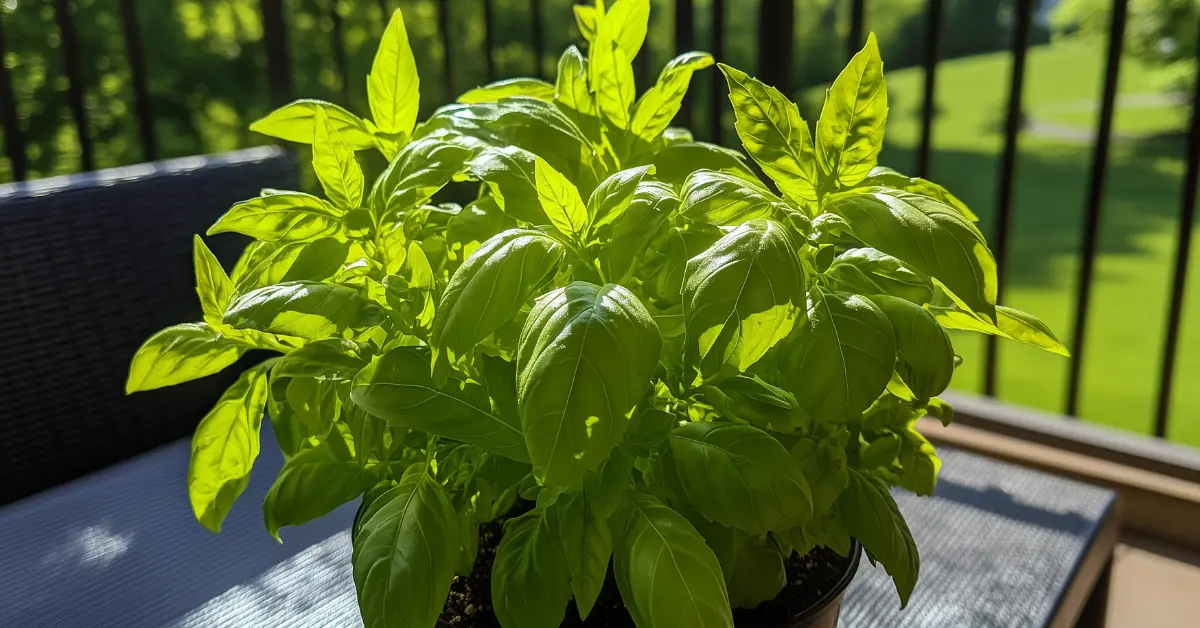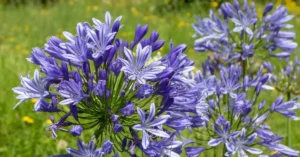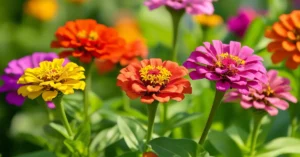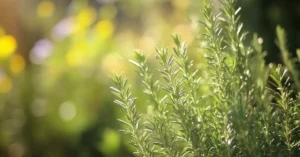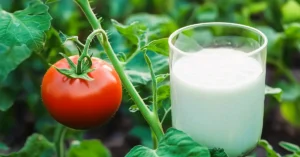If you’re looking to grow a basil bush in a pot, you’re in for a rewarding experience!
There’s nothing quite like the aroma of freshly harvested basil, and with the right care, your pot can become a thriving herb haven.
Imagine snipping off fragrant leaves to elevate your favorite dishes or whipping up homemade pesto right from your balcony!
In this guide, I’ll walk you through step-by-step tips to ensure your basil flourishes, from selecting the perfect pot to mastering watering techniques.
Let’s dive in and cultivate the biggest, most vibrant basil bush you can grow!,
Choosing the Right Environment

To successfully cultivate a robust basil bush in a pot, it is imperative to select an ideal environment that promotes healthy growth. Climate consideration plays a critical role, as basil flourishes in warm temperatures ranging from 70°F to 90°F.
Sunlight requirement is another essential factor; guarantee your basil receives at least 6 to 8 hours of direct sunlight daily. In particularly hot climates, providing afternoon shade can prevent wilting and sunburn.
Additionally, avoid placing the pot in areas prone to standing water, as this can lead to root rot. Securing good air circulation around the pot is crucial to mitigate the risk of fungal diseases. By addressing these environmental factors, you set the foundation for a flourishing basil bush.
Planting and Soil Preparation

Selecting the appropriate soil and potting method is essential for establishing a healthy basil bush. A high-quality potting mix should be utilized, ideally rich in organic matter and well-draining to prevent waterlogging.
Avoid using garden soil; its tendency to compact can hinder root growth. Instead, consider blending soil mixtures with composting materials, such as well-rotted manure or leaf mold, to enhance nutrient content and moisture retention.
Choose a pot that measures at least 12 inches in diameter and depth to accommodate the expansive root system. When planting, sow seeds at a depth of approximately ¼ inch or transplant seedlings carefully to minimize root disturbance. Proper soil preparation guarantees that your basil bush can thrive and flourish in its pot.
Watering Techniques

When it comes to nurturing a thriving basil bush, mastering effective watering techniques is crucial for promoting ideal growth and preventing common issues such as root rot.
Employing methods like drip irrigation can provide consistent moisture directly to the root zone while minimizing water waste. This technique guarantees that the soil remains evenly moist without saturation.
Alternatively, soaker hoses offer a gentle and efficient way to hydrate your basil bush, allowing water to seep slowly into the soil, fostering deep root development.
Monitor soil moisture regularly, and water when the top inch feels dry to the touch. By employing these techniques, you can maintain a healthy balance of moisture, ultimately supporting robust growth and maximizing your basil bush’s potential.
Fertilization Methods

Applying the right fertilization methods is essential for promoting healthy and vigorous growth in a basil bush. Utilizing organic fertilizers can substantially enhance the nutrient profile of your basil.
Compost tea, rich in microorganisms and nutrients, can be applied every two to three weeks to provide a natural boost. This liquid fertilizer aids in enhancing soil fertility and improving plant health.
Additionally, incorporating worm casting into the potting mix before planting or as a top dressing can offer a slow-release source of essential nutrients, such as nitrogen and phosphorus. This combination of compost tea and worm casting not only nourishes the plant effectively but also fosters a sustainable growing environment, allowing your basil bush to flourish naturally.
Pruning for Growth

To achieve ideal growth in a basil bush, effective pruning techniques are essential. Implementing strategic deadheading techniques, such as pinching off the top two sets of leaves when the plant reaches approximately six inches in height, encourages bushier growth and prevents flowering.
Regularly utilize appropriate pruning tools, including sharp shears or scissors, to guarantee clean cuts that minimize stress to the plant. Removing any weak or spindly stems facilitates air circulation and directs energy toward healthier growth.
Additionally, maintaining a consistent pruning schedule fosters a robust and vibrant basil bush, ultimately enhancing both yield and flavor. Embrace these practices to cultivate a thriving herb that can flourish in any pot.
Providing Support
Although basil plants can thrive independently, providing support is essential for optimizing their growth and maintaining structural integrity.
Utilizing trellis options, such as vertical grids or netting, can help encourage upward growth while maximizing sunlight exposure. These structures enable the basil bush to grow robustly without the risk of bending or breaking under its weight.
Alternatively, cage structures, similar to those used for tomatoes, can effectively cradle the plant, allowing for adequate airflow and minimizing the chance of fungal diseases.
When installing these supports, guarantee they are sturdy yet flexible enough to accommodate the plant’s growth. Regularly check and adjust the supports as needed to foster an environment where your basil can flourish freely and vigorously.
Pest Control Strategies

Maintaining the health and vitality of a basil bush requires diligent pest control strategies to combat potential infestations that can hinder growth and reduce yield.
Employing biological controls, such as introducing beneficial insects like ladybugs, can effectively manage pest populations without harming the plant. Additionally, organic repellents, including neem oil and insecticidal soap, serve as eco-friendly options for treating common pests like aphids and spider mites.
Regularly inspecting the foliage for early signs of infestations is essential, as prompt action can mitigate damage. Furthermore, maintaining ideal growing conditions—such as proper watering and air circulation—can bolster the plant’s natural defenses, further reducing reliance on chemical treatments. A proactive approach to pest management guarantees a robust and flourishing basil bush.
Harvesting Tips
Regular harvesting is essential for promoting a healthy and productive basil bush. To maximize yield, selectively pinch off individual leaves or cut entire stems just above a node, ensuring you do not remove more than one-third of the plant at a time.
This practice encourages continuous growth and prevents premature flowering. For long-term storage, consider freeze preservation; blanch the leaves briefly in boiling water before plunging them into ice water, then chop and freeze in ice cube trays.
Alternatively, employ drying methods by bundling stems and hanging them in a dark, dry area for several weeks. Once fully dried, store the leaves in airtight containers, preserving their flavor and aroma for culinary use throughout the year.
Have you ever planted basil at home? What is your best tip for a large, long-lasting plant?

